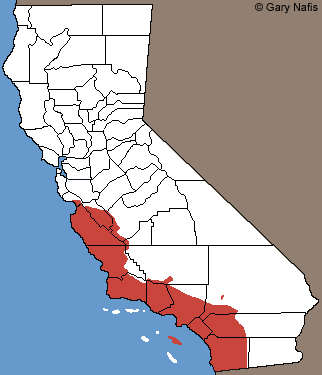Two-striped Gartersnake - Thamnophis hammondii
(Kennicott, 1860)Description • Taxonomy • Species Description • Scientific Name • Alt. Names • Similar Herps • References • Conservation Status
 |
|||||||||||||||||||||||||||||||||||||||||||||||||||||||||||
| Sub-adult in defensive pose, San Diego County | |||||||||||||||||||||||||||||||||||||||||||||||||||||||||||
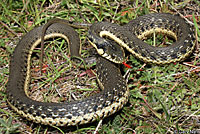 |
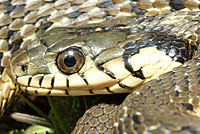 |
 |
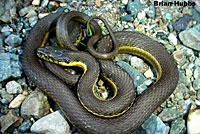 |
||||||||||||||||||||||||||||||||||||||||||||||||||||||||
| Sub-adult, San Diego County | Adult, Santa Barbara County © Brian Hubbs |
||||||||||||||||||||||||||||||||||||||||||||||||||||||||||
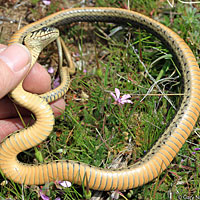 |
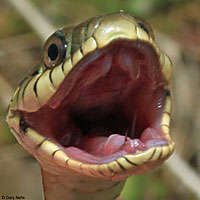 |
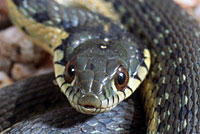 |
 |
||||||||||||||||||||||||||||||||||||||||||||||||||||||||
| Sub-adult, San Diego County | Sub-adult in defensive posture, San Diego County. This snake has flattened its head into a triangular shape to mimic a venomous snake to scare me away. | ||||||||||||||||||||||||||||||||||||||||||||||||||||||||||
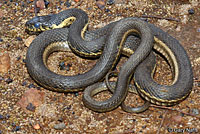 |
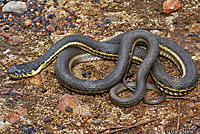 |
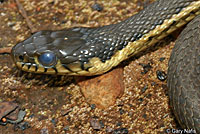 |
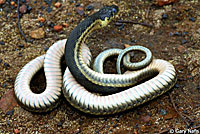 |
||||||||||||||||||||||||||||||||||||||||||||||||||||||||
| Adult, coastal San Diego County. Milky blue eyes and dull appearance show it is in the process of shedding its skin. | |||||||||||||||||||||||||||||||||||||||||||||||||||||||||||
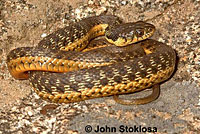 |
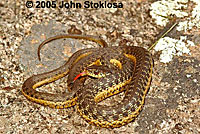 |
 |
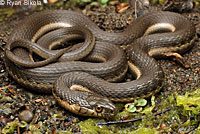 |
||||||||||||||||||||||||||||||||||||||||||||||||||||||||
| Adult, Laguna Mountains, San Diego County © John Stoklosa |
Adult, Ventura County © Jeremy Huff |
Adult, Santa Barbara County © Ryan Sikola |
|||||||||||||||||||||||||||||||||||||||||||||||||||||||||
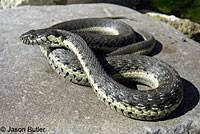 |
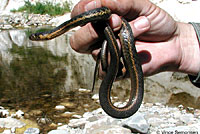 |
 |
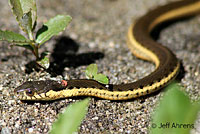 |
||||||||||||||||||||||||||||||||||||||||||||||||||||||||
| Adult, Santa Barbara County © Jason Butler |
An adult snake with a reddish stripe from just west of the Piru River in Ventura County. © Vince Semonsen | Adult, San Bernardino County © Jeff Ahrens | |||||||||||||||||||||||||||||||||||||||||||||||||||||||||
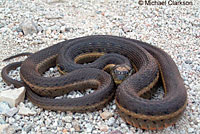 |
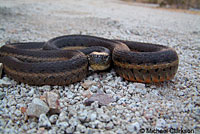 |
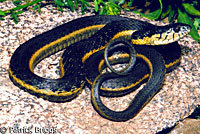 |
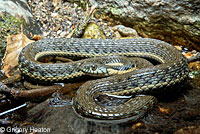 |
||||||||||||||||||||||||||||||||||||||||||||||||||||||||
| Adult from the Mohave Desert at Victorville, San Bernardino County © Michael Clarkson |
Adult, Ventura County © Patrick Briggs |
Adult, coastal San Gabriel Mountains, Los Angeles County © Grigory Heaton | |||||||||||||||||||||||||||||||||||||||||||||||||||||||||
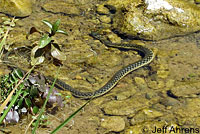 |
 |
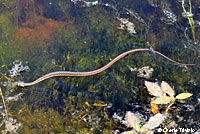 |
 |
||||||||||||||||||||||||||||||||||||||||||||||||||||||||
| Adult in creek, Orange County © Jeff Ahrens |
Adult in creek, Orange County © Jeff Ahrens |
Adult swimming in a flooded meadow in in the San Diego County mountains © Cherie Trivizo |
Adult, Riverside County © Jeff Ahrens |
||||||||||||||||||||||||||||||||||||||||||||||||||||||||
 |
 |
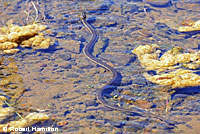 |
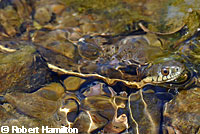 |
||||||||||||||||||||||||||||||||||||||||||||||||||||||||
| Adult in creek, San Bernardino County © Jeff Ahrens | Adult in an Orange County creek © Robert Hamilton | ||||||||||||||||||||||||||||||||||||||||||||||||||||||||||
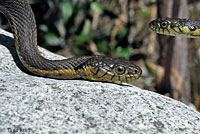 |
 |
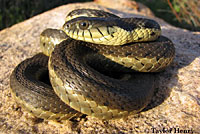 |
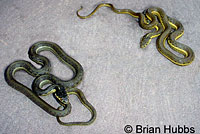 |
||||||||||||||||||||||||||||||||||||||||||||||||||||||||
| Adults, Santa Ana Mountains, Orange County © Tadd Kraft |
Adult, San Diego County © Paul Maier |
Adult, San Diego County © Taylor Henry | Sub-adults, two color phases, Ventura County. © Brian Hubbs |
||||||||||||||||||||||||||||||||||||||||||||||||||||||||
 |
 |
 |
|||||||||||||||||||||||||||||||||||||||||||||||||||||||||
| Adult, Santa Barbara County © Ryan Sikola |
Juvenile, San Benito County © Faris K | Adult, Santa Barbara County with a broad pale lower stripe similar to a Queen Snake. © Ryan Sikola | |||||||||||||||||||||||||||||||||||||||||||||||||||||||||
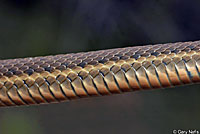 |
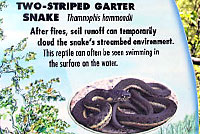 |
||||||||||||||||||||||||||||||||||||||||||||||||||||||||||
| The Two-striped Gartersnake typically has a single light stripe low on each side of the body but lacks the light stripe on top of the back which is present in most other species of gartersnake found in California. | Sign, San Diego County park | ||||||||||||||||||||||||||||||||||||||||||||||||||||||||||
| Aberrant Snakes - Dark Morphs, Unstriped, Unusual Pigmentation, Unusual Patterns | |||||||||||||||||||||||||||||||||||||||||||||||||||||||||||
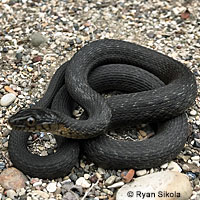 |
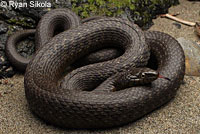 |
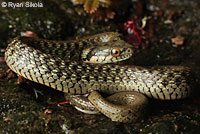 |
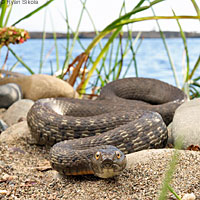 |
||||||||||||||||||||||||||||||||||||||||||||||||||||||||
| Melanistic adult without apparent stripes, San Luis Obispo County © Ryan Sikola | This melanistic adult without stripes Two-striped Gartersnake was observed in San Luis Obispo County. © Ryan Sikola | Juvenile, San Luis Obispo County without stripes. Juvenile snakes in this area start out lighter in color with a light belly then get darker with age. © Ryan Sikola |
Brown adult without stripes, San Luis Obispo County. © Ryan Sikola | ||||||||||||||||||||||||||||||||||||||||||||||||||||||||
 |
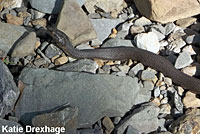 |
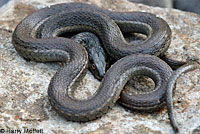 |
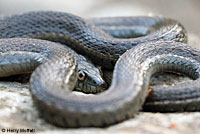 |
||||||||||||||||||||||||||||||||||||||||||||||||||||||||
| Melanistic adult without stripes, San Luis Obispo County © Katie Drexhage | Very dark striped adult, Monterey County © Harry Moffett | ||||||||||||||||||||||||||||||||||||||||||||||||||||||||||
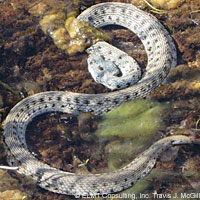 |
 |
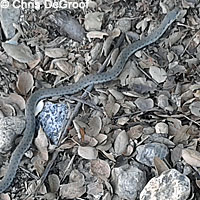 |
 |
||||||||||||||||||||||||||||||||||||||||||||||||||||||||
| This unusually-pigmented spotted morph was found in Riverside County. It's not an albino, because the eyes are dark, but it is missing some of its normal dark pigment. © ELMT Consulting, Inc. Travis J. McGill This snake has defensively flattened its head into a triangular shape to make it appear to be venomous. |
Spotted morph adult from Los Angeles County © Chris DeGroof | ||||||||||||||||||||||||||||||||||||||||||||||||||||||||||
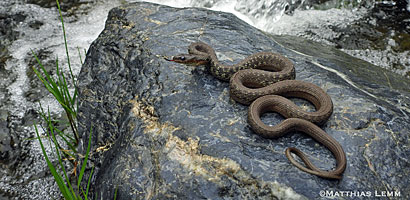 |
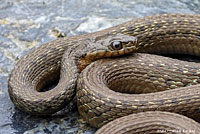 |
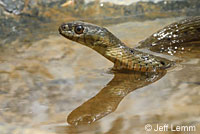 |
|||||||||||||||||||||||||||||||||||||||||||||||||||||||||
| Brown adult without stripes, Santa Catalina Island, Los Angeles County © Matthias Lemm | Brown adult without stripes, Santa Catalina Island, Los Angeles County © Jeff Lemm |
||||||||||||||||||||||||||||||||||||||||||||||||||||||||||
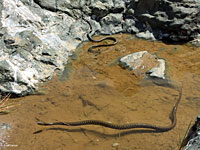 |
 |
||||||||||||||||||||||||||||||||||||||||||||||||||||||||||
| Brown adults without stripes, Santa Catalina Island, Los Angeles County © Jeff Lemm |
A very dark adult without stripes from the San Gabriel Mountains in San Bernardino County © Kyle Watson This snake has defensively flattened its head into a triangular shape to make it appear to be venomous. | ||||||||||||||||||||||||||||||||||||||||||||||||||||||||||
| Hybrids | |||||||||||||||||||||||||||||||||||||||||||||||||||||||||||
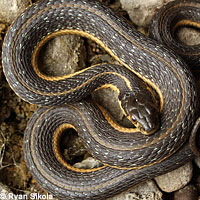 |
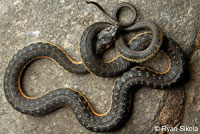 |
||||||||||||||||||||||||||||||||||||||||||||||||||||||||||
| Adult, Santa Barbara County © Ryan Sikola |
Adult, San Luis Obispo County © Ryan Sikola |
||||||||||||||||||||||||||||||||||||||||||||||||||||||||||
| These snake are unusual hybrids of the Two-striped Gartersnake and the Diablo Range Gartersnake, Thamnopis atratus zaxanthus. Note the thin yellow vertebral stripe that is not present on T. hammondii which is much thinner than the stripe found on T. atratus. T. atratus is so scarce at the edge of its range in San Luis Obispo and Santa Barbara counties that they breed with T. hammondii which is more abundant in the area. |
|||||||||||||||||||||||||||||||||||||||||||||||||||||||||||
| Two-striped Gartersnakes Feeding and Predation | |||||||||||||||||||||||||||||||||||||||||||||||||||||||||||
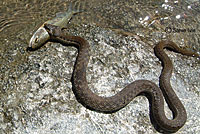 |
 |
 |
 |
||||||||||||||||||||||||||||||||||||||||||||||||||||||||
| Steve Ivie and his Cub Scout troupe saw this gartersnake enter a river in the San Gabriel Mountains of Los Angeles County. They watched the snake swim upstream and grab a trout about 8 or 9 inches in length, then drag the trout onto a rock at the edge of the river, and eat it, as you can see above. © Steve Ivie |
Adult eating a sucker on a rock next to the San Gabriel River, Los Angeles County. © Seth Coffman | ||||||||||||||||||||||||||||||||||||||||||||||||||||||||||
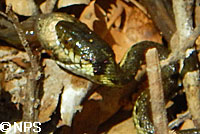 |
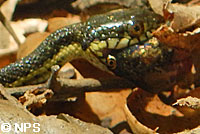 |
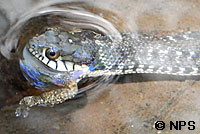 |
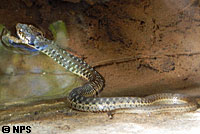 |
||||||||||||||||||||||||||||||||||||||||||||||||||||||||
| This juvenile snake is eating a Baja California Treefrog tadpole in the Santa Monica Mountains of Los Angeles County. © NPS |
This juvenile snake is eating a young California Treefrog in the Santa Monica Mountains of Los Angeles County. © NPS | ||||||||||||||||||||||||||||||||||||||||||||||||||||||||||
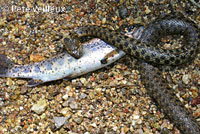 |
 |
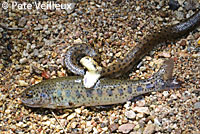 |
|||||||||||||||||||||||||||||||||||||||||||||||||||||||||
 |
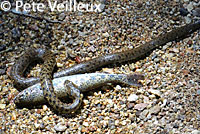 |
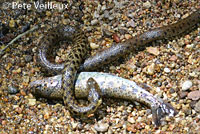 |
|||||||||||||||||||||||||||||||||||||||||||||||||||||||||
| Adult spotted morph T. hammondii eating a trout pulled from a pool in a Monterey County creek that dried up during the summer of 2014 due to the drought. © Pete Veilleux |
|||||||||||||||||||||||||||||||||||||||||||||||||||||||||||
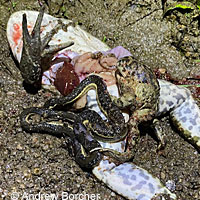 |
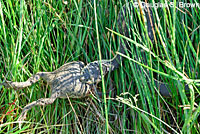 |
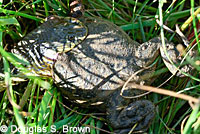 |
 |
||||||||||||||||||||||||||||||||||||||||||||||||||||||||
| This dead Two-striped Gartersnake was found in San Diego County inside the belly of an American Bullfrog along with an Arroyo Toad which was alive. When put back in the creek, the toad hopped away. © Andrew Borcher Animals captured and handled under authorization by the California Department of Fish and Wildlife. |
This adult Two-striped Gartersnake was observed eating a California Toad in San Diego County. It took the snake almost 45 minutes to completely swallow the toad, which had puffed its body up to make itself harder to swallow. You can also watch a YouTube video of the event:Two Striped Garter Feeds on a California Toad © Douglas S. Brown |
||||||||||||||||||||||||||||||||||||||||||||||||||||||||||
 |
 |
 |
|||||||||||||||||||||||||||||||||||||||||||||||||||||||||
| A Two-striped Gartersnake eating a Threespine stickleback, Gasterosteus aculeatus, in San Luis Obisp County © Ryan Sikola | |||||||||||||||||||||||||||||||||||||||||||||||||||||||||||
| Habitat | |||||||||||||||||||||||||||||||||||||||||||||||||||||||||||
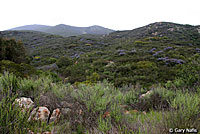 |
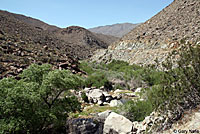 |
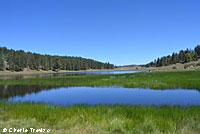 |
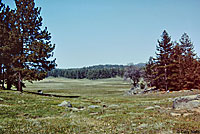 |
||||||||||||||||||||||||||||||||||||||||||||||||||||||||
| Habitat, coastal sage, San Diego County |
Habitat, desert creek, San Diego County |
Habitat, flooded meadow in Spring, San Diego County mountains © Cherie Trivizo |
Habitat, San Diego County mountain meadow |
||||||||||||||||||||||||||||||||||||||||||||||||||||||||
 |
 |
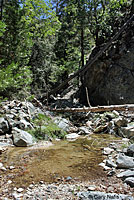 |
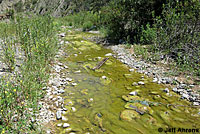 |
||||||||||||||||||||||||||||||||||||||||||||||||||||||||
| Habitat, coastal stream, San Diego County |
Habitat, San Gabriel Mountains, Los Angeles County |
Habitat, creek, 5,200 ft., San Gabriel Mountains, Los Angeles County |
Habitat, small creek, Orange County © Jeff Ahrens |
||||||||||||||||||||||||||||||||||||||||||||||||||||||||
 |
 |
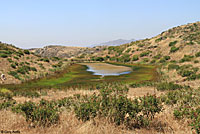 |
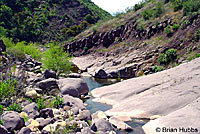 |
||||||||||||||||||||||||||||||||||||||||||||||||||||||||
| Habitat, lake edge, 4,600 ft. San Diego County |
Habitat, mountain creek, San Diego County |
Habitat, seasonal pond, San Diego County |
Riparian habitat, Ventura County. © Brian Hubbs |
||||||||||||||||||||||||||||||||||||||||||||||||||||||||
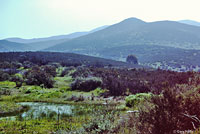 |
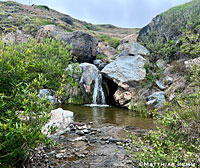 |
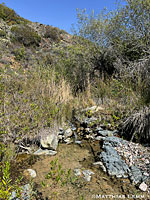 |
|||||||||||||||||||||||||||||||||||||||||||||||||||||||||
| Habitat, small creek, San Diego County |
Santa Catalina Island © Matthias Lemm | Santa Catalina Island © Matthias Lemm | |||||||||||||||||||||||||||||||||||||||||||||||||||||||||
| Short Video | |||||||||||||||||||||||||||||||||||||||||||||||||||||||||||
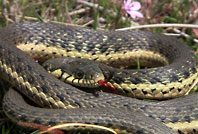 |
|||||||||||||||||||||||||||||||||||||||||||||||||||||||||||
| A Two-striped Gartersnake filmed in San Diego County. |
|||||||||||||||||||||||||||||||||||||||||||||||||||||||||||
|
|||||||||||||||||||||||||||||||||||||||||||||||||||||||||||
|
|||||||||||||||||||||||||||||||||||||||||||||||||||||||||||
|
The following conservation status listings for this animal are taken from the July 2025 State of California Special Animals List and the July 2025 Federally Listed Endangered and Threatened Animals of California list (unless indicated otherwise below.) Both lists are produced by multiple agencies every year, and sometimes more than once per year, so the conservation status listing information found below might not be from the most recent lists, but they don't change a great deal from year to year.. To make sure you are seeing the most recent listings, go to this California Department of Fish and Wildlife web page where you can search for and download both lists: https://www.wildlife.ca.gov/Data/CNDDB/Plants-and-Animals. A detailed explanation of the meaning of the status listing symbols can be found at the beginning of the two lists. For quick reference, I have included them on my Special Status Information page. If no status is listed here, the animal is not included on either list. This most likely indicates that there are no serious conservation concerns for the animal. To find out more about an animal's status you can also go to the NatureServe and IUCN websites to check their rankings. Check the current California Department of Fish and Wildlife sport fishing regulations to find out if this animal can be legally pursued and handled or collected with possession of a current fishing license. You can also look at the summary of the sport fishing regulations as they apply only to reptiles and amphibians that has been made for this website. The 2019 Special Animals List lists the population on Santa Catalina Island as a separate subspecies, Thamnophis hammondii pop. 1. - Santa Catalina gartersnake. The listing for pop. 1 of this snake is shown below the listings for the main populations of T. hammondii. These are the listings for Thamnophis hammondii - Two-striped Gartersnake: |
||||||||||||||||||||||||||||||||
| Organization | Status Listing | Notes | ||||||||||||||||||||||||||||||
| NatureServe Global Ranking | G4 | Apparently Secure | ||||||||||||||||||||||||||||||
| NatureServe State Ranking | S3S4 |
Vulnerable-Apparently Secure |
||||||||||||||||||||||||||||||
| U.S. Endangered Species Act (ESA) | None | |||||||||||||||||||||||||||||||
| California Endangered Species Act (CESA) | None | |||||||||||||||||||||||||||||||
| California Department of Fish and Wildlife | SSC | Species of Special Concern | ||||||||||||||||||||||||||||||
| Bureau of Land Management | S | Sensitive | ||||||||||||||||||||||||||||||
| USDA Forest Service | S | Sensitive | ||||||||||||||||||||||||||||||
| IUCN | LC | Least Concern | ||||||||||||||||||||||||||||||
|
||||||||||||||||||||||||||||||||
Return to the Top
© 2000 -

